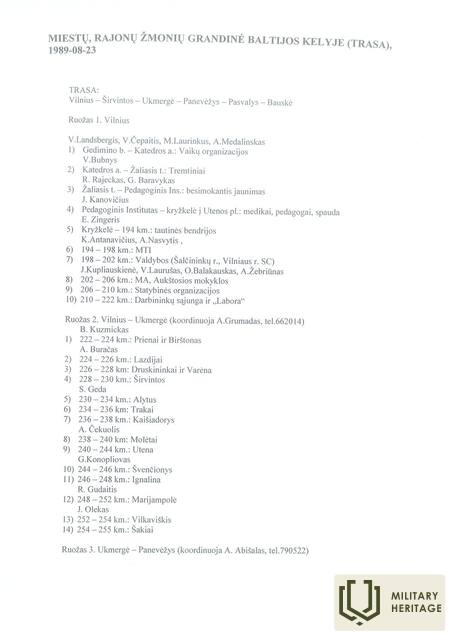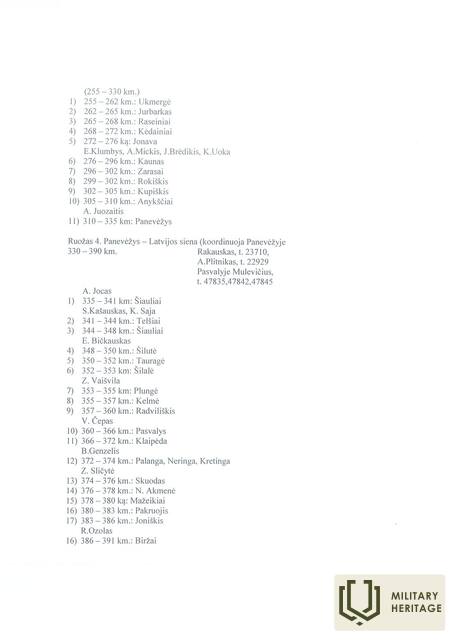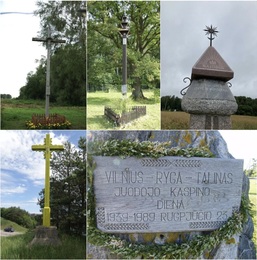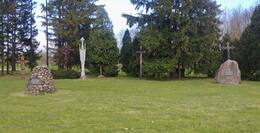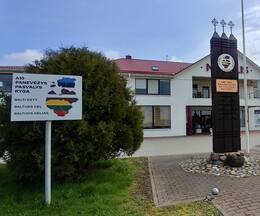Source: Memorandum for Baltic Way organizers
Documents related to the organization of the Baltic Way in 1989 are presented, revealing the organizational concerns of the campaign, its symbolic details, and their meanings.
A memorandum is presented to the organizers of the Baltic Way. The document reveals the usual organizational concerns, starting with issues of transport, catering, toilets, etc. However, it also records the meaningful highlights of the campaign: its pragmatic and symbolic goals are named, and the symbolic needs of its details are revealed. For example, the division of the road route into 50 “stages” was supposed to symbolize 50 years of the nation’s suffering. The organizers of the campaign even planned to attract “rockers” and play a role for them.
The illustrations include another document – a breakdown of the Baltic Way route by participating areas (cities, districts). The coordinators and leaders of individual sections of the route are also indicated, who are prominent figures of the revival and society.
The Baltic Way took place on August 23, 1989. Today, decades later, the memory of this great event and the material legacy (signs) along the former road route are still alive.
First newsletter
PROMOTION "BALTIC ROAD"
- Handshake on the road Vilnius-Širvintos-Ukmergė-Panevėžys-Pasvalys-Latvian border on August 23 at 7 p.m.
- The action symbolizes the solidarity and determination of the Baltic nations.
- Participation in the action must demonstrate our determination to move forward. We need to consolidate the nation again. This is a necessary condition for winning the elections.
–––––––––––
- The route is divided into 50 stages, symbolizing 50 years of suffering.
- On average, every 4 km there is an altar (burial mound).
- The altar is built by people who have arrived from the lands they brought, and is made of stones they brought.
- At least 2,000 people at each altar. Districts that can accommodate over 2,000 people serve a separate altar (provide information on which part of the route is most convenient for them to arrive).
- Large cities and districts serve several altars, dividing them into organizations. Do not avoid names of altars such as Sąjūdis, Mothers, Freedom, Democrats, St. Mary, Hope, Exile, Afghanistan, Gediminas, Vytautas, etc.
FIFTY ALTARS IN THE MIDDLE OF LITHUANIA
- It is necessary to convene all movements and organizations.
- To call on the church to help organize people.
–––––––––––
ALTAR
- It is advisable to give a name to the altar being served
- For each altar, an organizational group should be formed that would coordinate organizational issues with the local authorities, prepare a place for the altar in advance, erect chapel pillars or other accents indicating the place where the altar would be erected, where it would be convenient to hold a rally of 2-5 thousand people, a place where it would be convenient to park transport, coordinate the participation of a priest and possibly the holding of mass, coordinate the participation of a member of the Seimas or Council of the Lithuanian People's Republic, organize readers, poets, writers, the participation of a choir, ethnographic ensemble, etc., organize the reception of documents, appeals to the Supreme Soviet of the USSR, the Supreme Soviet of the Lithuanian People's Republic or Gorbachev, and the reading of documents adopted by the Seimas.
–––––––––––
PROMOTION
- Try to bring or invite people as early as possible (maybe even in the morning). Plan how to keep those who arrive occupied.
- If there are not enough people in the human chain, use black ribbons (necessarily prepared in advance) and candles, which will be placed in place of the missing people and will symbolize those who have died over the past 50 years.
- Plan in advance where people will be holding candles and where with ribbons. Organize the lighting of candles about 30 minutes before the start of the event.
- After the meeting (7 p.m.), gather people at the altar for a rally (mass), songs...
–––––––––––
ORGANIZATIONAL ISSUES
- Start taking care of gasoline and vehicles.
- Organize shuttle buses in cities along the route to bring people in and out. Transportation must be ensured for everyone.
- Arrange for arrivals with flags and paraphernalia.
- Attract cyclists and tourists, order them T-shirts with an inscription, for example, "For Lithuania, for the Sąjūdis", and organize their arrival the day before.
- To attract "rockers" for connections with adjacent altars.
- Organize a feeding point(s) with the help of cooperatives.
- Ensure medical assistance.
- Install a temporary outdoor toilet.
Organizational group
"The site of the first sign of the Baltic Way for Vilnius residents", in: Register of Cultural Properties, available online: https://kvr.kpd.lt/#/static-heritage-detail/e28e5f9b-31df-4a55-94a9-f4956ead08fa, newsletter , 1–2.
"The site of the first sign of the Baltic Way for Vilnius residents", in: Register of Cultural Properties, available online: https://kvr.kpd.lt/#/static-heritage-detail/e28e5f9b-31df-4a55-94a9-f4956ead08fa, Baltic Way 1989-08-23 route , 1–2.
Related objects
Monuments along the Baltic Way section to commemorate the Baltic Way
Along the Baltic Road from Vilnius to Škilinpamūšis.
On August 23, 1989, to commemorate the 50th anniversary of the signing of the criminal Molotov-Ribbentrop Pact and its secret protocols, a human chain was formed by the Lithuanian Reorganization Movement, the Latvian People's Front, and the Estonian People's Front, connecting the capitals of the three Baltic states – Vilnius, Riga, and Tallinn. 2 million people joined hands in a chain about 650 km long. This chain, known as the Baltic Way, is one of the most striking and memorable events in the Soviet-occupied countries' quest for independence.
The Baltic Way was for some time listed in the Guinness Book of World Records as the longest human chain, and the documentary heritage testifying to this event was included in the UNESCO International Register “Memory of the World”. However, alongside these global and international forms of commemoration, there are also more modest, but no less eloquent, forms. In Lithuania, signs dedicated to its memory have been erected along the entire Baltic Way (the road ran along the Vilnius–Ukmergė–Panevėžys–Pasvalys section). In the Pasvalys district alone, there are 12 such signs of memory today – monuments made of various materials and in various forms. And there are several dozen of them along the entire section. The monuments were erected on the initiative of the Baltic Way participants themselves.
The Baltic Way in Lithuania began in Vilnius from the Gediminas Castle Tower. Today, this starting point is marked by a medallion embedded in the castle stone. And in the Šeškinė microdistrict of Vilnius (along the Ukmergė highway, at Ukmergės g. 24) there is a wooden monument in the form of a chapel pillar, which can be considered the symbolic beginning of the marked path. Its symbolic end is the sign of the connection of the Lithuanian and Latvian sections of the Baltic Way, located 200 km away near Saločiai.
Cross Valley to Commemorate the Baltic Way
The Cross Valley to Commemorate the Baltic Way memorial is located on the eastern outskirts of Pasvalys on the Via Baltica motorway (E67, A10).
On 23 August 1989, to commemorate the occasion of the 50th anniversary of the signing of the criminal Molotov-Ribbentrop Pact and its secret protocol, based on the initiative of the Lithuanian reform movement “Sąjūdis”, the Latvian People’s Front and the Estonian People’s Front, a live human chain linked the capitals of the three Baltic states – Vilnius, Riga and Tallinn. Holding hands, approximately two million people joined together in a living chain that was about 650 km long. This chain, known as the Baltic Way, is one of the most remarkable and memorable events on the road to independence of the countries occupied
by the Soviets.
To commemorate this event, memorial signs have been erected along the Baltic Way route (Vilnius-Ukmergė-Panevėžys- Pasvalys-Saločiai). The Cross Valley to Commemorate the Baltic Way is one of the monuments dedicated to this memorial route. The history of Cross Valley began on the eve of the Baltic Way when the residents of Pasvalys started using boulders to build the Altar of Freedom. On 23 August, the crosses were installed in the valley by the participants of the Baltic Way from Pasvalys, Akmene, Joniškis, Kretinga, Mosėdis, and Pakruojis. Later, crosses were erected to commemorate important events and
people of note, as well as crosses dedicated to the friendly Norwegian and Swedish people.
Memorial Sign of the Lithuanian and Latvian Section of the Baltic Way
The memorial sign is located north of Škilinpamūšis, on the Via Baltica motorway (E67, A10), next to the Latvian border, on the right side of the motorway.
On 23 August 1989, the three Baltic nations – Lithuanians, Latvians and Estonians – united in a historic event called the Baltic Way. On this day, to commemorate the 50th anniversary of the Molotov-Ribbentrop Pact and its secret protocol, a spectacular non-violent resistance event was organised. Approximately two million people joined hands to form a human chain that stretched for 650 kilometres from Vilnius through Riga to Tallinn. The Baltic Way has become not only a symbol of solidarity but also a powerful message to the world about the determination of the Baltic states to regain their independence.
One of the most important monuments commemorating the event is the memorial sign on the Lithuanian-Latvian border, which was erected in 2014 based on the initiative of the members of the Lithuanian reform movement “Sąjūdis” and the organisers of the 1989 Baltic Way.




